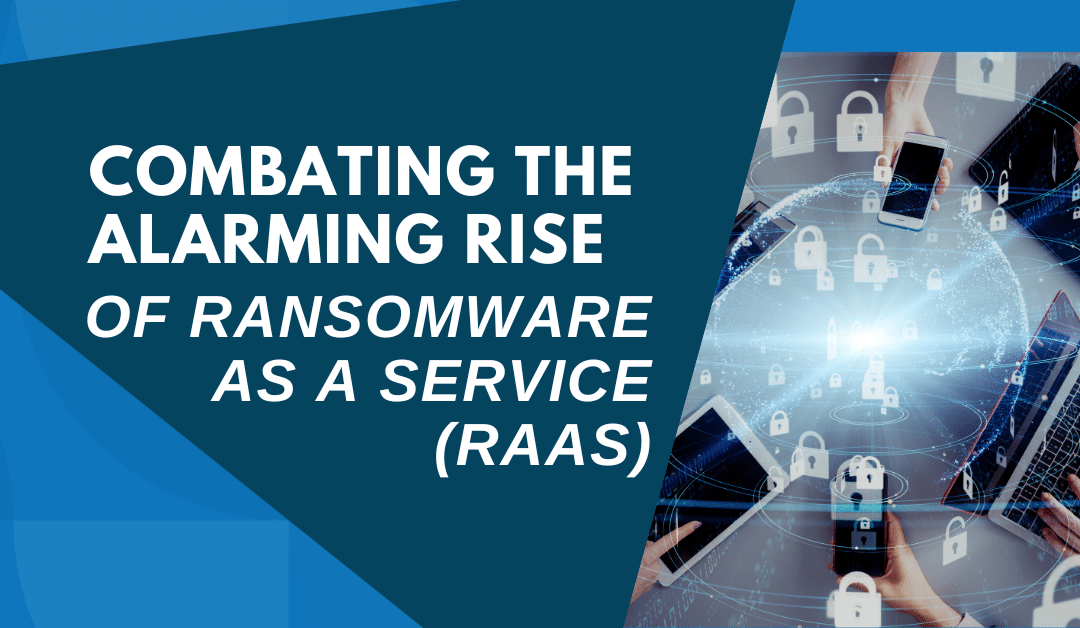In today’s digital landscape, Ransomware as a Service (RaaS) has emerged as a significant threat to businesses. RaaS enables cybercriminals to offer ransomware tools and infrastructure to anyone with malicious intent, no matter their coding ability, intensifying the risk of devastating attacks.
To put this into perspective, consider the case of the infamous GandCrab ransomware. Introduced in early 2018, GandCrab operated on the RaaS model, leasing the ransomware to affiliates who distributed it for a share of the profits. Countless victims fell prey to GandCrab, enduring significant financial losses and grappling with the challenging process of recovery.
What makes RaaS even more alarming is the accessibility it provides. Anyone, regardless of technical expertise, can access RaaS platforms with round-the-clock support. You can equate this model to any type of Software as a Service (SaaS) tools you use currently, like Microsoft 365 or Slack. This ease of access, combined with the IT knowledge gap in cybersecurity, leaves businesses vulnerable to these orchestrated attacks.
In this blog post, we delve into the crucial topic of protecting businesses from RaaS attacks. We explore the adoption of comprehensive security measures and best practices that organizations can implement to safeguard their systems and data. By staying informed and proactive, you can fortify your defenses against this growing menace and mitigate the potential damage caused by RaaS attacks.
The IT Knowledge Gap and the Need for Comprehensive Protection
Many organizations continue to rely on basic security measures, assuming they are adequately protected against ransomware attacks. However, the reality is that cybercriminals are constantly evolving their tactics, and traditional security measures alone are no longer sufficient to mitigate the risks associated with RaaS. Businesses must acknowledge the need for comprehensive cybersecurity solutions that go beyond the basics.
According to Group-IB’s research, the number of companies that had their information uploaded onto dedicated leak sites (DLS) between H2 2021 and H1 2022 was up 22% year-on-year to 2,886. This implies that approximately eight companies have their data leaked online every single day, largely driven by the pervasive RaaS model. It’s worth noting that ransom demands have escalated significantly in the past year.
Additionally, the increased accessibility and affordability of initial access to corporate networks offered by brokers on the dark web have further contributed to the prevalence of these attacks. Over the past year, there has been a 100% increase in instances of corporate access being sold, with the number of brokers growing to 380, thus driving down prices by approximately 50%.
Overall, the IT knowledge gap in cybersecurity combined with the rise of RaaS models and increased accessibility of initial access to corporate networks on the dark web leaves businesses alarmingly susceptible to these cyber threats. This reinforces the need for robust cybersecurity measures and training for all employees.
In the era of RaaS, it is crucial for organizations to implement multi-layered security strategies that encompass advanced threat detection systems, employee education and awareness programs, regular data backups, and incident response plans. Proactive measures like vulnerability assessments and penetration testing can help identify weak points in the network infrastructure and address them before cybercriminals exploit them.
Moreover, businesses must invest in robust endpoint security solutions to protect their devices and networks from ransomware infiltration. This includes utilizing next-generation antivirus software, intrusion prevention systems, and encryption technologies to safeguard sensitive data.

The Financial Implications of RaaS Attacks
When faced with such attacks, the demand for ransom payments and potential data loss can result in significant financial strain.
A recent study estimated that the average cost of a ransomware attack for businesses is approximately $1.85 million. This figure includes expenses related to incident response, system restoration, legal assistance, regulatory compliance, and reputational damage control.
Additionally, according to Cybersecurity Ventures, the financial impact of ransomware is tremendous and continues to escalate. The total cost of ransom payments is predicted $10.5 trillion by 2025—the “greatest transfer of economic wealth in history.“
This underscores the urgency and necessity of implementing robust cybersecurity measures in businesses of all sizes, especially smaller organizations, which could face even more devastating impacts due to limited resources and recovery capabilities.

Disruptive Consequences on Business Operations
Ransomware as a Service (RaaS) attacks can have far-reaching consequences beyond financial losses. Organizations may face prolonged business disruptions, loss of customer trust, and damage to their brand reputation. It can take months or even years to regain the confidence of customers, partners, and stakeholders, which can further impact the bottom line.
Here are three significant impacts to consider:
1. Revenue Loss:
- Operational Downtime: RaaS attacks can cripple your business by rendering critical systems and data inaccessible, leading to operational downtime.
- Missed Opportunities: Downtime and inability to serve customers can result in missed sales opportunities and delayed projects.
- Dissatisfied Customers: Customers affected by the disruption may become dissatisfied and seek alternative providers, leading to potential revenue loss.
2. Customer Trust Erosion:
- Breached Data: RaaS attacks that compromise customer data erode trust and violate privacy.
- Customer Attrition: The fallout from data breaches can result in customer attrition as individuals lose confidence in your organization’s ability to protect their information.
- Negative Publicity: News of a successful RaaS attack can spread rapidly, leading to negative headlines and public scrutiny.
3. Brand Reputation Damage:
- Public Perception: Successful RaaS attacks can damage your brand’s image and market position, leading to a loss of trust and credibility.
- Questioned Security Practices: Customers, partners, and stakeholders may question your organization’s security practices, impacting future engagements.
- Legal Ramifications: RaaS attacks may have legal consequences, such as fines or legal actions, further tarnishing your brand’s reputation.
Remember, resilience lies in your ability to anticipate, prepare, and respond effectively to the evolving cyber threat landscape.

Protecting Your Business from RaaS Attacks
Protecting your business from Ransomware as a Service (RaaS) attacks requires a comprehensive cybersecurity strategy. Adopting a multi-layered approach that includes network security, data encryption, regular backups, and strong access controls is crucial. Continuous monitoring and updating of security measures are essential to stay ahead of evolving threats.
First and foremost, conducting regular risk assessments is crucial to protect your small business against these cyber threats. Identify the weak points in your infrastructure, systems, and processes that may make you an easy target for RaaS attacks. Implementing robust security measures, such as strong access controls, data encryption, and network segmentation, can significantly mitigate these risks.
Equally important is educating your employees about cybersecurity best practices. Offer comprehensive training programs that raise awareness about phishing scams, social engineering tactics, and safe online behavior. By fostering a culture of cyber vigilance, you empower your team to act as the first line of defense against RaaS attacks.
Lastly, developing an incident response plan is paramount. Outline clear procedures to follow in the event of a breach or ransomware incident. This includes regular backups of critical data, testing the restoration process, and establishing communication channels to quickly address and contain the situation.
Partnering with Managed Service Providers (MSPs) can provide expertise and resources to enhance your cybersecurity posture. MSPs offer round-the-clock monitoring, threat detection, and incident response capabilities, relieving the burden on your internal IT team. Outsourcing cybersecurity to MSPs is especially beneficial for small businesses that may lack the resources to implement advanced security technologies independently.
In today’s digital landscape, the risk of RaaS attacks is ever-present. It is crucial for businesses, regardless of size, to invest in cybersecurity measures, bridge the IT knowledge gap, and take immediate action to secure their digital assets. By prioritizing cybersecurity and staying proactive, you can effectively defend against Ransomware as a Service attacks and ensure a secure digital future for your business.
Follow Us!




Recent Comments